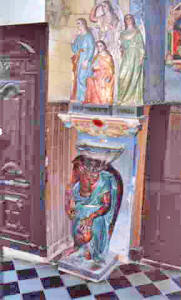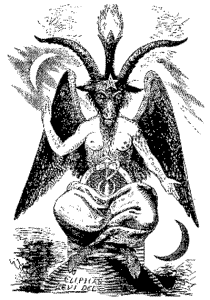|
Cain
The Forgotten Father
from
OrdoLapsitExillis Website
recovered through
WayBackMachine Websit
The
Forgotten Father
Many secret orders have an Outer Head -
a non-corporeal entity who is recognized as that order’s true
Grand Master, for whom the corporeal Grand Master is but
a representative. It is similar to the concept of the patron deity.
For us, we understand the Ordo Lapsit Exillis to be under the
guidance of the spirit of Cain, the god-king of the ancient
world immortalized in legends as mankind’s Forgotten Father.
Cain is said to have created civilizations across the globe,
and to have shared with certain chosen men a secret, forbidden
wisdom: the Hermetic doctrine of the occult, symbolized by the
Lapsit Exillis, or the Holy Grail. These actions brought
him into conflict with other members of the divine hierarchy, an
occasion immortalized in the Biblical story of the War in Heaven,
and in other myths from various cultures that tell the same story.
He is also said to have interbred with mortal females, creating
mankind’s first royal family, the Grail bloodline, which
carried with it the seed of the divine. Their descendants became the
lords of the earth, resulting in many, if not in fact most of the
world’s royal dynasties throughout history. The Grail gene
can even be found in numerous other important personages from both
the past and the present, including every single president of the
United States.
The archetypal figure of Cain can be found in an astonishing
variety of myths and legends from divers places and periods. Notable
ones include:
And although Cain is himself a
Biblical figure, major elements of his story are repeated in the
Biblical (and Apocryphal) tales of:
-
Enoch
-
Tubal-Cain
-
Noah
-
Abraham
-
Isaac
-
Jacob
-
Nimrod
-
Melchizedek
-
King Hiram of Tyre
-
Archangel Michael
-
even Christ
himself
However, the Cain archetype is
most famously represented in the villains of the Bible, such
as Satan, Lucifer, Leviathan, and the
Anti-Christ.
Cain is even portrayed in the
church at
Rennes-le-Chateau, as the statue of
the demon Asmodeus - Rex Mundi, the Lord of the
Earth - which stands in the church entryway. Cain is not
always depicted as exclusively male, for in occult symbolism he is
sometimes conjoined in Hermaphroditic fashion with his female
consort, represented by the Venusian goddess archetype. In
this manner Cain was worshipped by the Knights Templar
in the form of their androgynous idol, Baphomet.
 
Asmodeus
Baphomet
The secret doctrine passed down
from Cain to his descendants has been preserved in the
various
secret occult societies that the
Grail families have formed throughout the ages, albeit in
sometimes fragmented and incoherent form. It is the goal of
Lapsit Exillis to rediscover the secret doctrine of the Grail -
the forbidden knowledge first taught by Cain - and
restore it to its original glory, in a pure and unblemished state.
In the Bible, Cain was exiled to the Land of Nod,
and what became of him after is not specified, except that he is
known to have founded great kingdoms. Of his death and burial,
nothing is said. But the legends of other cultures pick up where the
Bible leaves off. In numerous myths, the body of the
Forgotten Father is said to be entombed within a subterranean
chamber, located in the cave of a sacred mountain in the center of
the Earth. There he is, not dead, but eternally sleeping, and his
dreams still have the power to influence the actions of mortal men
upon the Earth’s surface. One day, it is said, upon the arrival of
the new Golden Age, he will return to once again shepherd his
flock. Until then, his servants work in secret to prepare the
way.
We need not speculate about the literal truth of notions such as
these in order to derive use from them. To us, regardless of the
scientific principles which may or may not be involved, the divine
influence of the spirit of Cain upon the work of the OLE
(Ordo Lapsit Exillis) can most definitely be felt. Because of
this, we are obliged to acknowledge the insight and guidance that we
have received from him, and thus are compelled to pledge our
steadfast, unswerving obedience to him and his principles. It is a
pledge we feel quite confident in making, and a servitude that
brings us nothing but joy. To us, Cain will always be the
rightful Roi du Monde.
If the Rulers have the Divine
Right to govern, the true initiate will cheerfully obey.
- Albert Pike,
Morals and Dogma
Lucifer’s Children
The Grail Bloodline and the Descendants of
Cain
by Boyd Rice
Oct 20, 2004
Conventional wisdom has it that the Grail bloodline is sacred
because it came from Christ, a man still considered by much of the
world to be the true son of God. And yet the dynasty of kings who
descended from this bloodline were known as sorcerer-kings, some of
whom hinted or even stated outright that they were in fact
descendants of Lucifer. A number of authors claim this thesis is
true, but they are predominantly hardcore Christian conspiracy
theorists, and stop well short of explaining why they believe this,
or of giving any tangible details to substantiate their claims. Says
one: “In typical Gnostic fashion, descendants of the Merovingians
claim to have the blood of both Christ and Satan in their veins.”
Given the fact that this theme (or a variation of it) recurs with
some regularity, and given that it would appear to be consistent
with the sort of dual vibe which permeates the saga of this
bloodline, I began to wonder if there might not be some traditions
from which such a notion could have arisen. At length, several were
discovered.
Firstly, let’s remember that this bloodline descended from a figure
who equates with the Biblical Cain. In certain rabbinic lore, we
come across the very interesting notion that Cain was not the son of
Adam, but of Samael. It was thought that when Samael appeared to Eve
as a serpent, he seduced her. The fruit of that union was Cain. Now
Samael was a fallen angel, essentially the Judaic Lucifer. If the
Merovingians knew of this version of the story (which they no doubt
did), and believed it, it could be the basis of their alleged
assertion that they possessed the blood of both Christ and Lucifer.
An alternate version of the Cain saga, equally Luciferian in its
connotations, says that he was the son of Adam’s first wife, Lilith.
She had been the consort of God before coming to Earth as a fallen
angel. The full details of her story are probably too well-known to
bear repeating here, but it’s interesting that of the two alternate
traditions concerning Cain’s parentage, both involve the Luciferian
Nephilim bloodline. Also of interest is the fact that the lily is
known to have taken its name from “Lilith”, and the heraldic device
emblematic of this bloodline is the fleur-de-lys (widely accepted as
symbolic of the lily.) Could not this symbol, viewed within this
context, in fact be the “Flower of Lilith”?
The Lilith/Samael connection is also pertinent in regard to the
Grail saga insofar as the two have a son of their own who seems to
play a recurring role in the whole mythos: Asmodeus. Not only is
Asmodeus the dominant image (shown mirroring Christ) in
Rennes-le-Chateau, he is said to have played the central role in
building the Temple of Solomon, the edifice from which the Knights
Templar took their name. The recurrence of this strange figure in
Grail lore has long perplexed observers, yet it would appear that
both he and the descendants of Cain may in fact have shared a
kindred ancestry. It is even said in some traditions that it was
Asmodeus whom Moses called upon to part the Red Sea, and not God.
Though portrayed as a demon or devil figure, his name reveals that
he may not always have been viewed as such, for Asmodeus translates
simply to the Lord God (Ashma = Lord, and Deus = God).
Another possible genesis of the idea of a Luciferian bloodline may
have come from the Elohim, who in the Bible say: “Let us make man in
our image.” Elohim is generally thought to be a plural of God, or to
be “the gods.” But it is also widely believed to denote the Nephilim,
the fallen angels known as the Watchers in The Book of Enoch. It is
believed that the word “Elohim” comes from the much more ancient
Babylonian word “Ellu”, which means “Shining Ones.” This phrase has
a distinctively Luciferian connotation, because the name “Lucifer”
literally means “light bearer.” And the descendants of Cain, who
were the deified kings of Sumeria, bore the title of “Ari”, a term
which also meant “Shining Ones.” The Sumerian pictogram for “Ari” is
an inverted pentagram, a symbol long associated with Lucifer. And
the phrase “Shining Ones” would be a very apt description for the
descendants of Enoch’s fallen angels, who were said to have hair
white as snow, pale eyes, and pale skin which seemed literally to
glow and fill the room with light.
The Sumerian Ari are almost always
depicted as wearing crowns bearing horns, and some of their
descendants were said actually to have had horns. For instance, the
most famous statue of Moses (that of Michelangelo) depicts him with
horns atop his forehead, not wholly inappropriate for someone who
may be a blood relation of Asmodeus. Theologians protest that they
are not horns, merely rays of light. But even rays of light suggest
a Luciferian subtext. Alexander the Great declared himself the son
of God, and he too was said to have horns. In fact, to this very
day, if you talk to people on the streets of Iran (who remember his
invasion as though it happened last week), they will tell you in all
solemnity that it’s a historical fact that Alexander had horns,
which he wore his hair long to cover up.
In closing, we note the fact that Cain seems to have engendered his
own tradition, as evidenced in a strange Gnostic sect called the
Cainites. Like the Carpocrateans, the Cainites believed that no one
could be saved except by “making the journey through everything.”
Epiphanius describes them as a group “consecrating... lustful or
illegal acts to various heavenly beings” as a sort of sacrament.
Interestingly, many scholars compare them to... Satanists.
The extent to which the Merovingians knew of these alternate
traditions is uncertain. Whether or not they believed in them is
more uncertain still, yet it remains likely that they both knew
about these traditions and took them quite seriously. To this very
day, the coat of arms of the capital of the Merovingian empire,
Stenay, bears an image of the Devil. And the original name of Stenay
was “Satanicum.”
|

